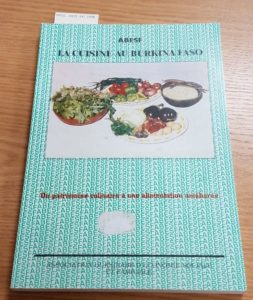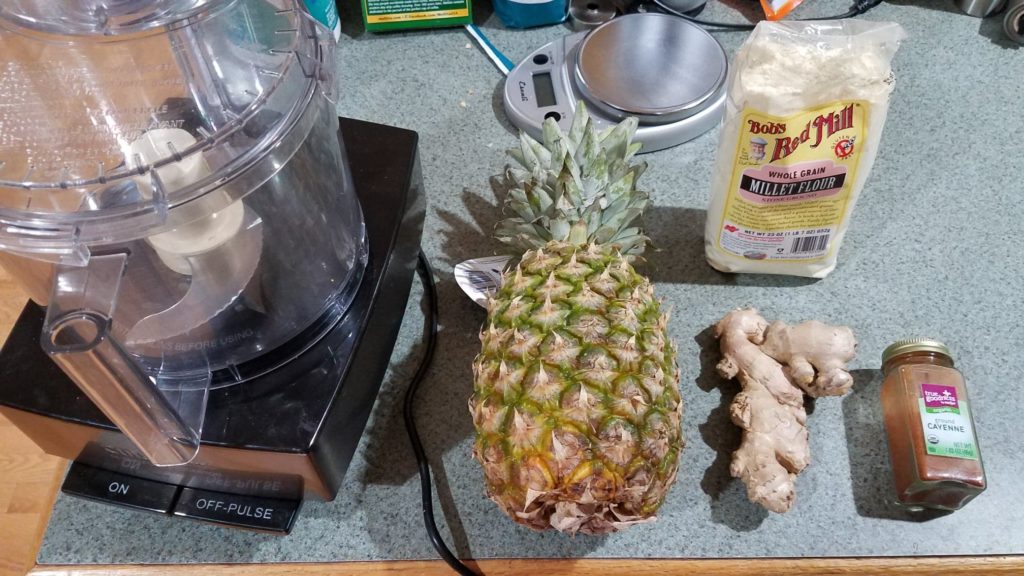Burkina Faso begins a run of a lot of African countries coming up – six of the next eight, including this one. The variety of foods from the continent is stunning, but are we good enough researchers to make meaningful differentiations? Probably not.
Fortunately, we’ll likely keep doing what we did for THIS meal, and just steal all the recipes from Cooked Earth. No shame in that, right? We’re not pretending to be an amazing source of recipes for OTHER people, just documenting our own attempts for the three people that actually care. (Hi mom!)
To be fair, I DID attempt to do some research on this one. I discovered that Michigan State University has a cookbook collection, so I went to check out their one and only Burkinabe cookbook:
For starters – it’s in French. This was a bit of a problem, as I don’t remember my two years of French from Ms. Carr’s class in 1988. Second problem – as far as I can tell, this book is a SUPER colonialist attempt by a Canadian NGO to tell Burkinabe folks how to prepare their own traditional dishes in a way that’s more nutritional. While that may or may not be a laudable goal, the whole thing comes across as horrifyingly patronizing.
And the third problem is the following:

Go ahead and Google translate “Chenilles” – I’ll wait. Or you can just look at the picture.
*pause for Googling*
Even if I thought I could convince Leigh to eat caterpillars, I’m really not sure I can find a good local source of the edible kind. And I’m not brave enough to just go out and scoop up wollybears and toss them into a pot. You’d probably need to peel them or something.
So, back to Cooked Earth it was. Fortunately, they had a set of very tasty looking recipes made with things we CAN find or order.
Starting with Zoom Koom, which is great fun to say. Zoom Koom literally means “flour water” and is an extremely… hearty beverage served to start a meal. It contains pineapple, ginger, tamarind extract, a pinch of hot pepper, and… (checks notes) a cup and a half of millet flour? That’s pretty hearty, all right.
We started by boiling whole tamarinds for a while to make tamarind liquid. We’ve used the paste before, but never the original fruits. They’re sticky and kind of a pain to work with, but the results are delicious. You strain out the solids, and then just mix all this stuff together. The final drink was very, very thick, but quite refreshing and tasty.
Our main course consisted of two dishes – a fried black eyed pea fritter called “boussan touba”, and a goat and rice stew. For the fritters, we soaked and then boiled black eyed peas, mixed them with carrot and onion, and then fried them in peanut oil. The recipe only called for one egg and no water as a binder, but they pretty much disintegrated like that, so we added some more water to get them to hold their shape. Next time I might try another egg instead.
The main course was a basic stew – goat, carrot, cabbage, and onion simmered together for a long time, with the rice added at the end to cook in the liquid. The new ingredient to us for this one was Carolina Gold rice, which is apparently significantly closer to the varietal found in West Africa than your basic supermarket long grain. We ordered that on the internet, and it was definitely different – chewier and more flavorful, for sure.
Here’s some “in process” photos:
The fritters also allowed us to use up the peanut oil we had purchased for Belgium, which was (checks notes)… even longer than last time ago.
With everything cooked up, it was time to eat!
Overall, a very tasty meal! The goat stew was flavorful and delicious, the pea fritters were crunchy on the outside and soft in the middle, and the Zoom Koom was probably the highlight – what’s not to like about pineapple, ginger, and tamarind? It was, however, so thick that we actually had trouble drinking it around the ice cubes.
The next day, I made a peanut lime sauce to eat with the rest of the fritters. Not authentic, but very tasty.
So Burkina Faso – we appreciate you! Three dishes all suitable for preparation on a weeknight, and tasty leftovers for several days. Next up, another African country – we finish up the “B”s with Burundi, and our first attempt at a meal that is both vegan and gluten free. And not only free of vegans, but also safe for them to eat!
Recipes here:
Cooked Earth blog – Burkina Faso





